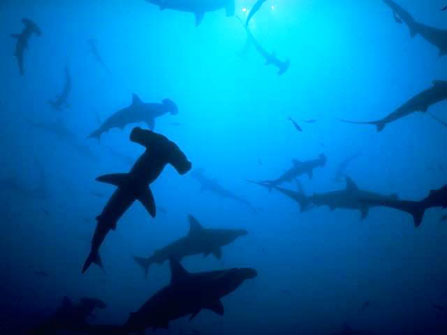Mexico seeks compliance with international shark fishing norms

Since 2014, the Convention on the International Trade of Endangered Species of Flora and Fauna, CITES, has controlled the commerce of three species of Hammerhead and Whitetip Sharks, all found in Mexican waters. (Photo: Mauricio Hoyos).
CIUDAD DE MÉXICO
Mexico has 106 species of shark, many of which are present in the Gulf of California, and many that are vulnerable or endangered. Such is the case of the Shovelnose shark (Sphyrna tiburo). Other species are candidates for comercialization. And there are many others that experts know very little about.
In light of these reasons and as a signatory of the Convention on the International Trade of Endangered Species of Flora and Fauna (CITES), Mexico held a workshop June 8-10, 2015 in which the current state of conservation of Mexican sharks was evaluated.
More than 30 experts from academic institutions, NGOs, government agencies, and the environmental and fishing sectors met in Mexico City, their goal to evaluate the susceptibility, productivity, and management of sharks in national waters.
“The cure for fear and over exploitation lies in knowledge and sustainable use,” was the theme of the meeting.
They recommended the following: improve the exchange of information between authorities and researchers; systematize the analysis of capture logs; employ the results of genetic studies to delimit shark populations; and consider other factors causing pressure on both species and fisheries, such as climate.
Additionally they suggested: implementing measures to strengthen the ability to extract and disseminate information on fish landings (catch); monitor the implementation of current measures that restrict the capture of hatchlings and juveniles; consider other possible measures, such as quotas, minimum or maximum sizes, and no fishing zones, among others; carry out education and advertisement campaigns to promote compliance of said measures, taking advantage of the experience of civil society organizations in working with fishing communities; consider alternatives and incentives for fishermen faced with the regulation measures that are being implemented; and exploring options that give added value to products promoting sustainable, legal, traceable, and just production chains.
They agreed to do the following:
-
Develop a joint agenda to revise and address the recommendations derived from the workshop;
-
Collaborate in the verification of the shark species to which fins being exported belong;
-
Meet to outline measures for compliance with Mexico’s environmental standards and measures beyond a ban that could contribute to the formulation of Non-Detriment Findings (NDFs), required by CITES from the National Commission on Knowledge and Use of Biodiversity (Conabio).
-
Use the proposal as presented by Conabio on conversion factors of body weight to fins, as well as consider other measures or carry out other studies, in order to help issue the NDF;
-
Review past experiences of international evaluations of Mako and Bigeye Thresher sharks using the Stock Synthesis software; and
-
Provide information about blue sharks and other species of of commercial importance in order to include them in the evaluation.
